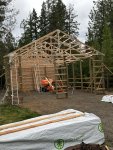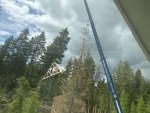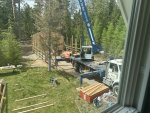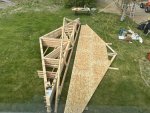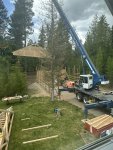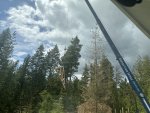Just about ready to give her a workout!
- Thread starter Selkirk_D
- Start date
North Idaho Wolfman
Moderator
Staff member
Lifetime Member
Equipment
L3450DT-GST, Woods FEL, B7100 HSD, FEL, 60" SB, 743 Bobcat with V2203, and more
It would be a super smart chose to put the foam and pipe in! 
Put a vapor barrier under the foam and you'll have a super nice shop to work in.


Put a vapor barrier under the foam and you'll have a super nice shop to work in.
Where are you getting foam for $1475?? I’m seeing closer to $6 grand for 1500 sfI started buying materials for my house back in 2010 and stock piled a lot of it.
But almost all of the electrical and plumbing I didn't do until 2020 as I wanted the most up to date Equipment I could get.
Yes parts are not cheap, but they are only slightly higher than the last build I did 2 years ago.
I also built a second copy of my house 2 years ago.
I buy everything from some great supply houses, that I don't pay anywhere near local costs for parts.
The pex is $233.59 for 1000ft you would need 2 rolls to do all of it perfectly.
$1475.00 in foam, yes that's the expensive part of it.
That's all you need to do now, you can do a boiler and all other parts later.
The boiler you would use is $1299.77 for 199,000 BTU.
You would be looking at about $600 in supporting parts.
I have three zones in my garage and it's 1080 SF, for 1500 SF you would want to do 4 zones.
What foam boards are you looking at that are $125?
It isn't $1500, but for $2800....
https://www.lowes.com/pd/Owens-Corn...553115?idProductFound=false&idExtracted=false
It isn't $1500, but for $2800....
https://www.lowes.com/pd/Owens-Corn...553115?idProductFound=false&idExtracted=false
North Idaho Wolfman
Moderator
Staff member
Lifetime Member
Equipment
L3450DT-GST, Woods FEL, B7100 HSD, FEL, 60" SB, 743 Bobcat with V2203, and more
HD, 2" R-tech $1,544.40
This is closed cell foam, so it's good for below grade, where other "white foams" are open cell and are not suitable below grade because they absorb water.


This is closed cell foam, so it's good for below grade, where other "white foams" are open cell and are not suitable below grade because they absorb water.
Hi density Foam specifically for under slab at Home Depot. I also found this which is supposedly good for under slab:

North Idaho Wolfman
Moderator
Staff member
Lifetime Member
Equipment
L3450DT-GST, Woods FEL, B7100 HSD, FEL, 60" SB, 743 Bobcat with V2203, and more
The above pics are of our foundation on our house and garage.
R-tech was used everywhere.
House is 2800SF, Garage is 1050SF
House is winter and summer 64-68 degrees depending on room, garage is 60 degrees.
We only heat with Propane and hydronic heat and my bill last year was $1200 for all heat and domestic hot water, so a very efficient house.
We have all my domestic water lines under the foam and we never have warm water in a cold line, so I'm not getting heat transfer into the ground under the slab.
I tested this foam from summer of 2013 till 2019 and got no water absorption or degrading, I got no loss in R valve, and it does not compress when used under slab.
I have several homes and buildings that have used this foam and everyone of them has the same results.
I did do my due diligence and have a proven track record with using it.
I have also used the pink and blue foam in the past and got the same results for way more money!
If spending $500 more make you happy go for it.
If you want to borrow my foam staple gun for the pex just let me know.
R-tech was used everywhere.
House is 2800SF, Garage is 1050SF
House is winter and summer 64-68 degrees depending on room, garage is 60 degrees.
We only heat with Propane and hydronic heat and my bill last year was $1200 for all heat and domestic hot water, so a very efficient house.
We have all my domestic water lines under the foam and we never have warm water in a cold line, so I'm not getting heat transfer into the ground under the slab.
I tested this foam from summer of 2013 till 2019 and got no water absorption or degrading, I got no loss in R valve, and it does not compress when used under slab.
I have several homes and buildings that have used this foam and everyone of them has the same results.
I did do my due diligence and have a proven track record with using it.
I have also used the pink and blue foam in the past and got the same results for way more money!
If spending $500 more make you happy go for it.
If you want to borrow my foam staple gun for the pex just let me know.
North Idaho Wolfman
Moderator
Staff member
Lifetime Member
Equipment
L3450DT-GST, Woods FEL, B7100 HSD, FEL, 60" SB, 743 Bobcat with V2203, and more
Pex pipe need to have an oxygen barrier for hydronic heating. 
Check out places like Pex universe, as they have the best prices on PEX.
Check out places like Pex universe, as they have the best prices on PEX.
Man, you're getting boned on that. $28 here.HD, 2" R-tech $1,544.40
This is closed cell foam, so it's good for below grade, where other "white foams" are open cell and are not suitable below grade because they absorb water.
View attachment 154089
View attachment 154091
The only thing I don't like about that foam board is it is only 10 psi rated where the pink stuff is 25 psi.
Most literature will say 10 psi compression rating should not be used for below slab. It can be used below GRADE ie. walls/footers in vertical positions but it's not designed for below slab. The pink stuff you pointed out is designed for below slab and thus cost ~2X as much (and is XPS vs EPS or polyiso). I'm sure you could use the 10 psi stuff BUT studies show this compresses a bit over time due to unlevel aggregate (gravel/rocks etc) and loses it's R value quickly in the compressed areas. A 4" concrete slab only weighs about .4 lbs per square inch so it would seem that 10 psi rated foam would be more than enough but if you have a structural engineer sign off on it they will most likely ask for EPS rated at 25 psi. I've heard that 10 psi EPS (2") below slabs can feel 'bouncy' or a bit hollow vs 25 psi or 35 psi EPS. You can hear/feel the difference if you bounce a golf ball off the concrete floor with the different rated insulations-the higher the compression rating of the insulation, the higher the ball will bounce. Probably not going to park a 12K forklift in your houses basement but for a shop you never know what might end up in there. For my shop, with 6" slab, engineering has recommended 35 psi rated below slab insulation. It cost about $45-$50 per 4X8 sheet. Maybe overkill but I know i'm not gambling on a 4000 square foot floor. Also, Zones 4-8 require R10 below slab with an additional R5 for the perimeter (2 feet from ext wall) if the floor is heated for a total of R15 (current IRC code stuff). Personally i like my slabs with a minimum of 6" 3/4 crushed rock (clean), minimum of 20 mil vapor barrier, 2" rigid insulation, 6" concrete (for a shop, 4" for basement/house is fine). This feels great with no bounce. Insulation above the vapor barrier is a must for me as even though EPS and very water resistant (as is XPS and Polyiso), they all drop in R value with any amount of moisture absorbed. They'll absorb some moisture out of the concrete during cure but that will evaporate out over time vs the constant moisture they would see if installed beneath the vapor barrier. 2 cents.Man, you're getting boned on that. $28 here.
The only thing I don't like about that foam board is it is only 10 psi rated where the pink stuff is 25 psi.
Thanks for the info. I’m going 6” on the slab so 25 psi is probably better.Most literature will say 10 psi compression rating should not be used for below slab. It can be used below GRADE ie. walls/footers in vertical positions but it's not designed for below slab. The pink stuff you pointed out is designed for below slab and thus cost ~2X as much (and is XPS vs EPS or polyiso). I'm sure you could use the 10 psi stuff BUT studies show this compresses a bit over time due to unlevel aggregate (gravel/rocks etc) and loses it's R value quickly in the compressed areas. A 4" concrete slab only weighs about .4 lbs per square inch so it would seem that 10 psi rated foam would be more than enough but if you have a structural engineer sign off on it they will most likely ask for EPS rated at 25 psi. I've heard that 10 psi EPS (2") below slabs can feel 'bouncy' or a bit hollow vs 25 psi or 35 psi EPS. You can hear/feel the difference if you bounce a golf ball off the concrete floor with the different rated insulations-the higher the compression rating of the insulation, the higher the ball will bounce. Probably not going to park a 12K forklift in your houses basement but for a shop you never know what might end up in there. For my shop, with 6" slab, engineering has recommended 35 psi rated below slab insulation. It cost about $45-$50 per 4X8 sheet. Maybe overkill but I know i'm not gambling on a 4000 square foot floor. Also, Zones 4-8 require R10 below slab with an additional R5 for the perimeter (2 feet from ext wall) if the floor is heated for a total of R15 (current IRC code stuff). Personally i like my slabs with a minimum of 6" 3/4 crushed rock (clean), minimum of 20 mil vapor barrier, 2" rigid insulation, 6" concrete (for a shop, 4" for basement/house is fine). This feels great with no bounce. Insulation above the vapor barrier is a must for me as even though EPS and very water resistant (as is XPS and Polyiso), they all drop in R value with any amount of moisture absorbed. They'll absorb some moisture out of the concrete during cure but that will evaporate out over time vs the constant moisture they would see if installed beneath the vapor barrier. 2 cents.
And just like that ….Boom! Trusses! Just need 2 more sections of purlins.
Attachments
-
893.5 KB Views: 19
-
733.7 KB Views: 20
-
937 KB Views: 20
-
1,015.1 KB Views: 19
-
909.1 KB Views: 17
-
709.5 KB Views: 16


